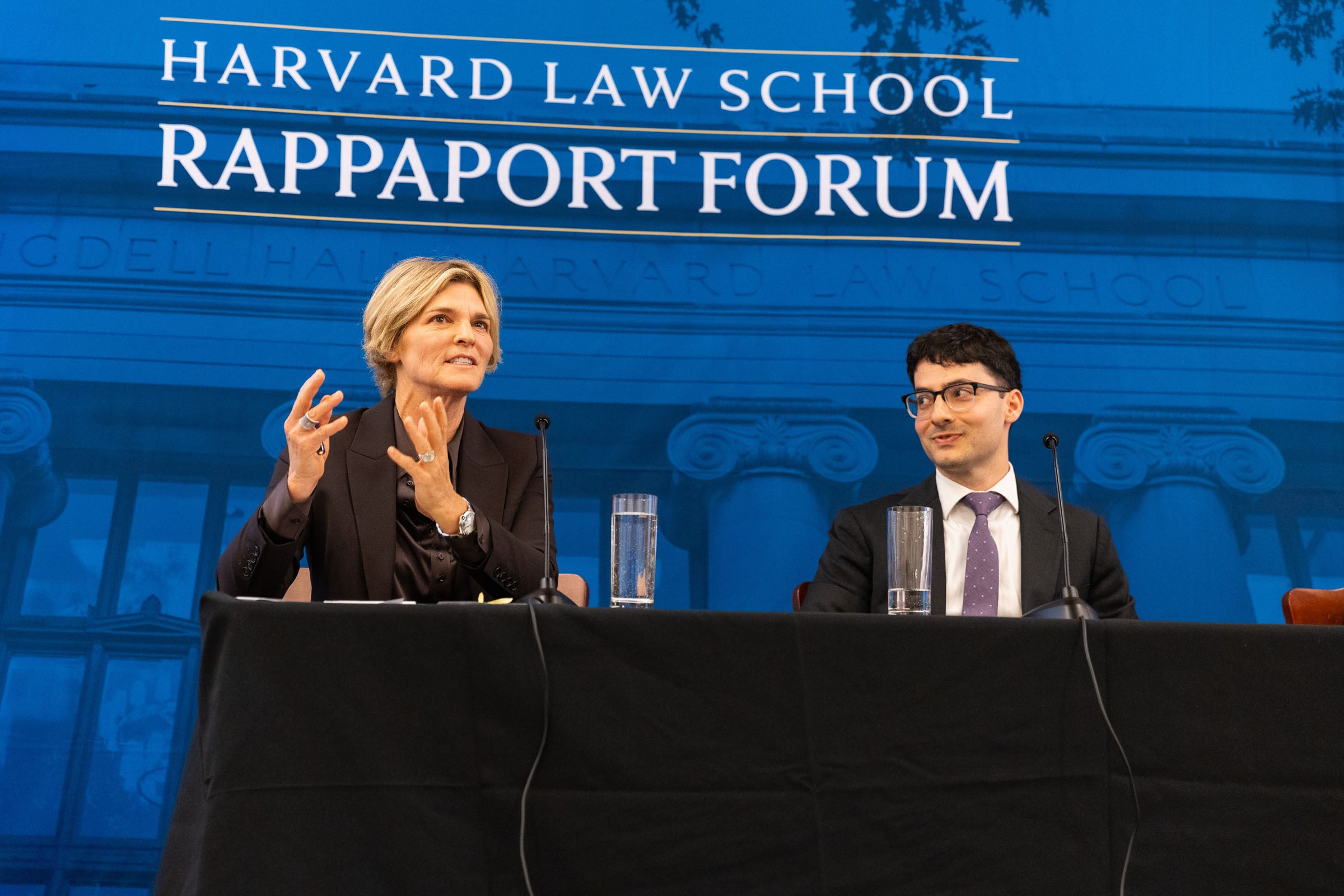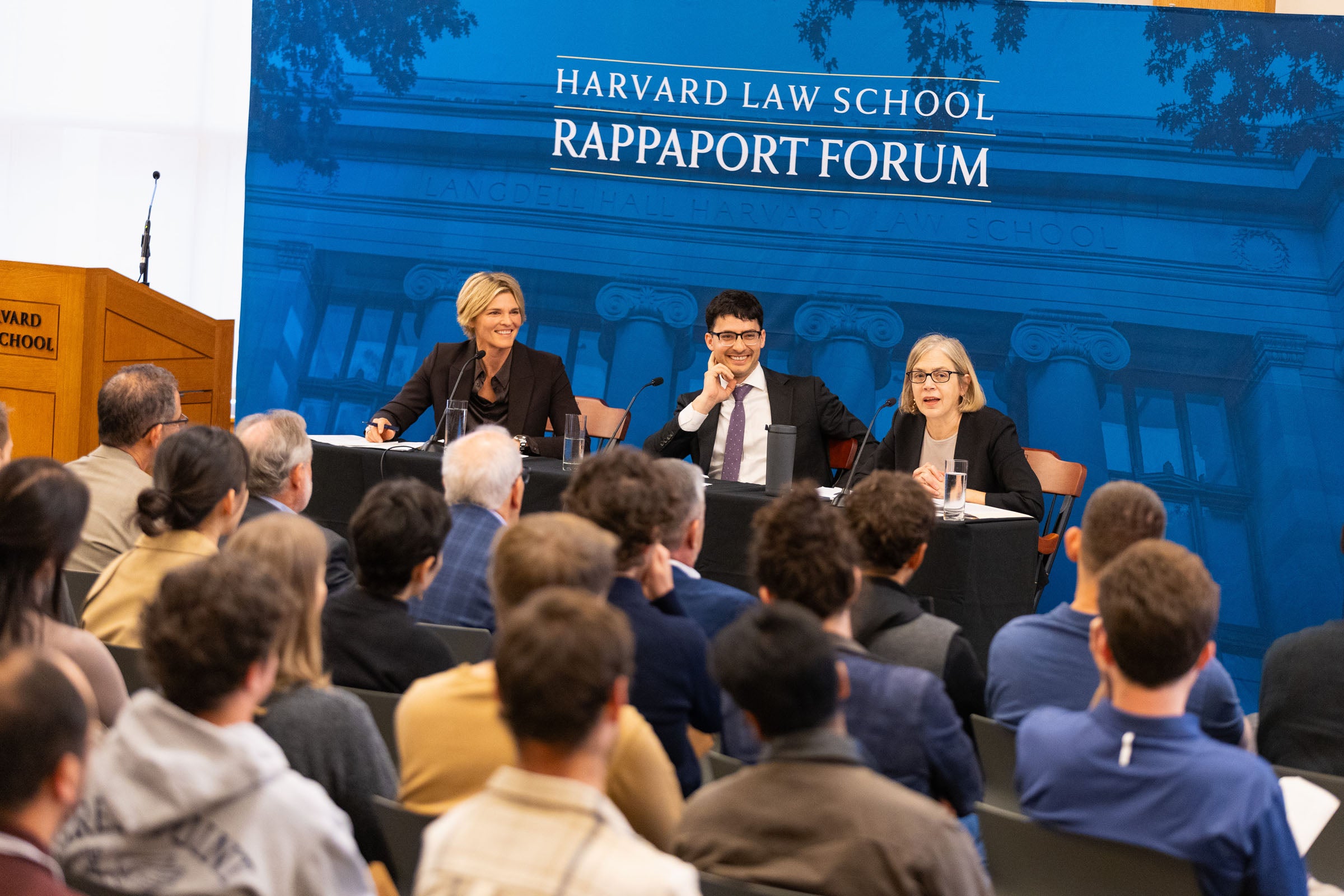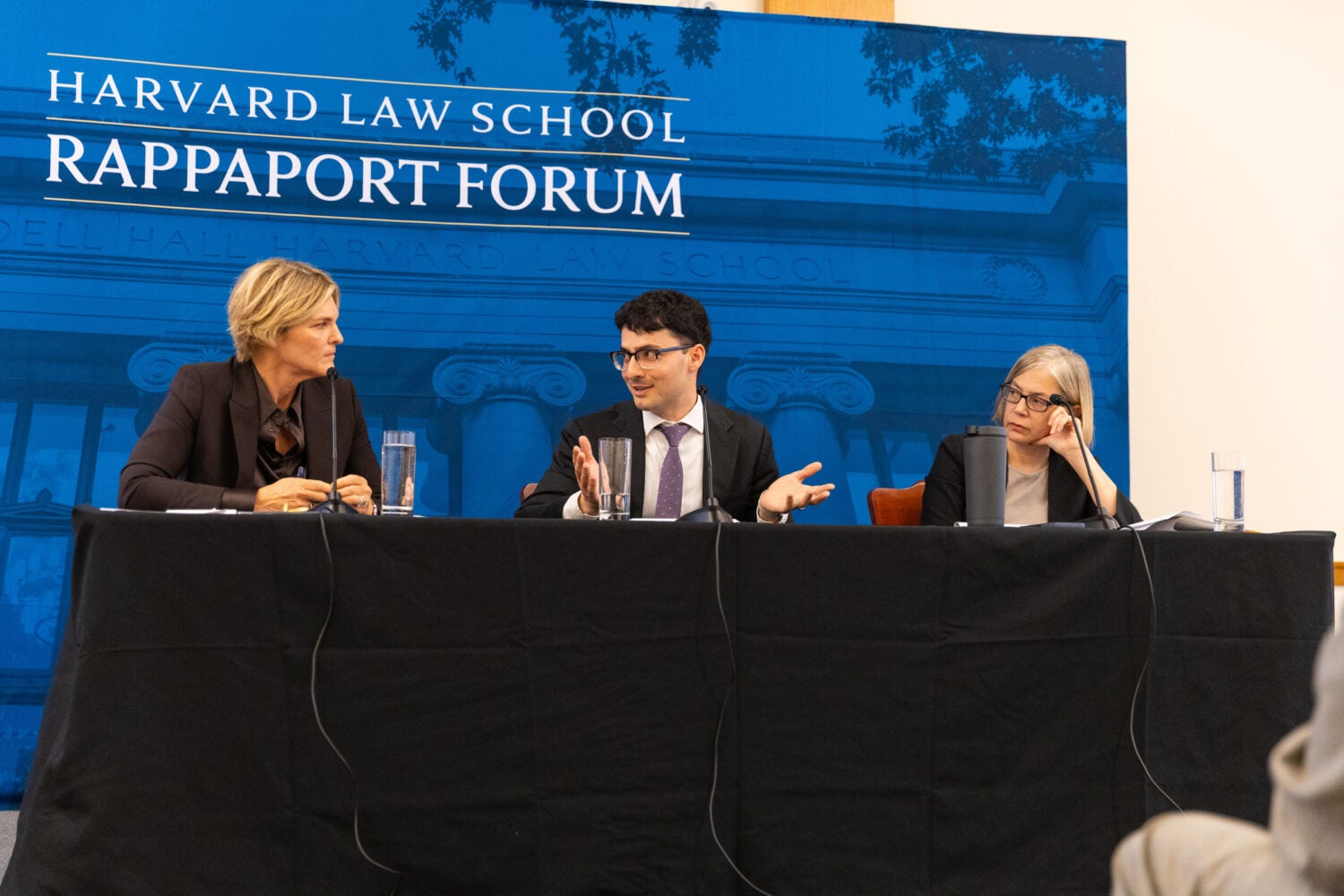Reports of the death of the administrative state have been greatly exaggerated — at least, according to legal experts at Harvard Law School’s Rappaport Forum on Tuesday.
“Not only do I feel fine about the [Supreme] Court’s administrative law decisions, I feel quite well,” said Ilan Wurman, an associate professor of law at the University of Minnesota. “And the question is, why doesn’t everyone?”
Wurman took the stage with Gillian Metzger, the Harlan Fiske Stone Professor of Constitutional Law at Columbia Law School, to debate the future effectiveness of federal agencies, such as the Department of Justice, the Environmental Protection Agency, and the Department of the Interior, following a string of recent Supreme Court decisions, including 2023’s Loper Bright v. Raimondo. In that case, a majority of justices overturned the longstanding doctrine known as Chevron deference — or the idea that courts should generally defer to government agencies in interpreting the laws they administer.
While Metzger agreed that the Court’s decisions did not exactly spell the end of the administrative state, she was far less optimistic about agencies’ ability to solve important problems moving forward. “Agencies are going to be way more cautious,” she said. “I think that courts are claiming greater and greater authority over administrative decision-making and adopting implausibly narrow views of agency power.”
“I think that courts are claiming greater and greater authority over administrative decision-making and adopting implausibly narrow views of agency power.”
Gillian Metzger
Jody Freeman LL.M. ’91 S.J.D. ’95, the Archibald Cox Professor of Law at Harvard Law School, who moderated the discussion, kicked off the event by noting the unusual buzz the Loper Bright decision had generated last year.
Chevron had “leapt the fence from the world of technical legal doctrine to the world of common conversation,” she said. “Barbra Streisand was posting on X about Chevron. You know when that happens that something has gone crazy.”
Freeman wondered if all that attention was justified. “What does this mean doctrinally? What does this mean in terms of real-world implications for agencies implementing laws in the world?”
From Wurman’s perspective, the real question was why the rulings weren’t unanimous. “Some of the Supreme Court’s recent and controversial administrative law decisions should have been 9-0,” he said.
That’s because, in Wurman’s view, little separates the majority opinion in Loper Bright and Justice Elena Kagan’s dissent, especially considering Kagan’s controlling opinion in the 2019 case Kisor v. Wilkie.



In Kisor, Kagan wrote that a court must exhaust all the traditional tools of statutory construction to divine statutory meaning, Wurman said. “A court should not afford deference unless the regulation is genuinely ambiguous,” he explained. “The Court’s theory of deference is that sometimes the law runs out and policy-laden choice is what is left over.”
The majority opinion in Loper Bright, Wurman insisted, agrees with Kagan’s reasoning.
“It seems to me that the dissent [in Loper Bright] is saying courts should rigorously construe statutes, but sometimes the law runs out, leaving policymaking discretion to the agency. And it seems to me that the majority is saying courts should rigorously construe statutes, but sometimes the law runs out, leaving policy making discretion to agency,” he said.
“Yes, I repeat myself,” he added for emphasis.
Wurman then turned to the major questions doctrine, another recent — and controversial — development in administrative law, which asserts that agencies must have unambiguous authority to take actions with a significant impact.
“If textualists resolve ambiguities by trying to ascertain which of multiple meanings the legislature likely intended, then I think the major questions doctrine accurately accounts for the legislative process,” he said.
Congress often likes to punt policy questions to agencies, he recognized. And sometimes its language is purposely vague. “But the question is whether legislators are likely to delegate the resolution of tough questions through ambiguities, through oblique language,” he said, adding that at least one study suggested that Congress typically does not do so.
“Some things just matter too much to be left to guesswork,” Wurman said.
‘Increasingly and unjustifiably hamstrung’
Metzger was less sanguine. “I am not so fine,” she said of some of the Court’s recent decisions. “But I also don’t think the administrative state is ending.”
Instead, she believes that agencies are being stripped of their ability to solve important problems. “I do think … it is becoming increasingly and unjustifiably hamstrung.”
She linked the decisions — which she viewed as “not politically and ideologically neutral” — to broader trends such as the Tea Party movement and Project 2025, which bills itself as a “historic movement … to take down the Deep State and return the government to the people.”
The recent rulings “can’t be viewed just through a doctrinal lens,” she said. “This judicial pullback … is part of a broader anti-administrative turn in the country, with greater political divides over administrative government.”
And the skepticism toward administrative authority goes beyond the Supreme Court, Metzger said. “We are talking also about circuit courts and district courts, a lot of whom are even more opposed to administrative power and [are] adjudicating cases that are obviously political, brought by red states or blue states, for example.”

Loper Bright “does leave room for administrative interpretations to still govern,” she conceded. In fact, “courts have started to uphold agencies more on their textual analysis, and agencies are putting more effort into their textual analysis.”
But still, Loper Bright “introduces tremendous uncertainty and transaction costs” to the agencies’ work, Metzger said. “It is not worth putting in the time to develop an interpretation that is just going to be reversed in a couple of years by the courts.”
All of this adds up to a less nimble federal government, she said. “Agencies are going to end up with more constrained authority and much less flexibility to deal with new circumstances and needs.”
Freeman then asked the panelists to reflect on a portion of the Loper Bright opinion that acknowledged that sometimes Congress purposely leaves agencies with flexibility. So, she asked, have we just swapped Chevron deference for a rule that looks for intent by Congress to grant interpretive leeway, under Loper Bright?
Yes, agreed Wurman. “That’s more or less my point,” he said, adding that under this new scheme, there is no deference available when there is uncertainty as to the actual meaning of the words in the statute, but a court will generally respect an agency’s view in “policymaking, gap-filling, legislative discretion that the words, properly interpreted, leave the agency.”
Metzger countered that she believed the line between what is legislative gap-filling and what is not remains unclear. “I also don’t think that every interpretive question is a question of policy,” she added.
And if the lines aren’t always visible to legal scholars, that is likely to be the case for those tasked with running the agencies as well, Metzger said. “This leads to more dominance of lawyers and legal thinking, which is not going to lead necessarily to the most intelligent, effective regulatory scheme.”
Yet Wurman indicated that he didn’t believe “the sky is falling.” “If the effect of the Loper Bright decision” was to get rid of an agency’s ability to misinterpret a statute’s wording but allows for more fighting in the middle about gap-filling, “then I’m still sleeping well,” he said.
For Metzger, the complexity of the arguments papered over a very simple meta concern. “Where is the power going to be, is it going to be with courts, or is it going to be with agencies?”
Want to stay up to date with Harvard Law Today? Sign up for our weekly newsletter.
